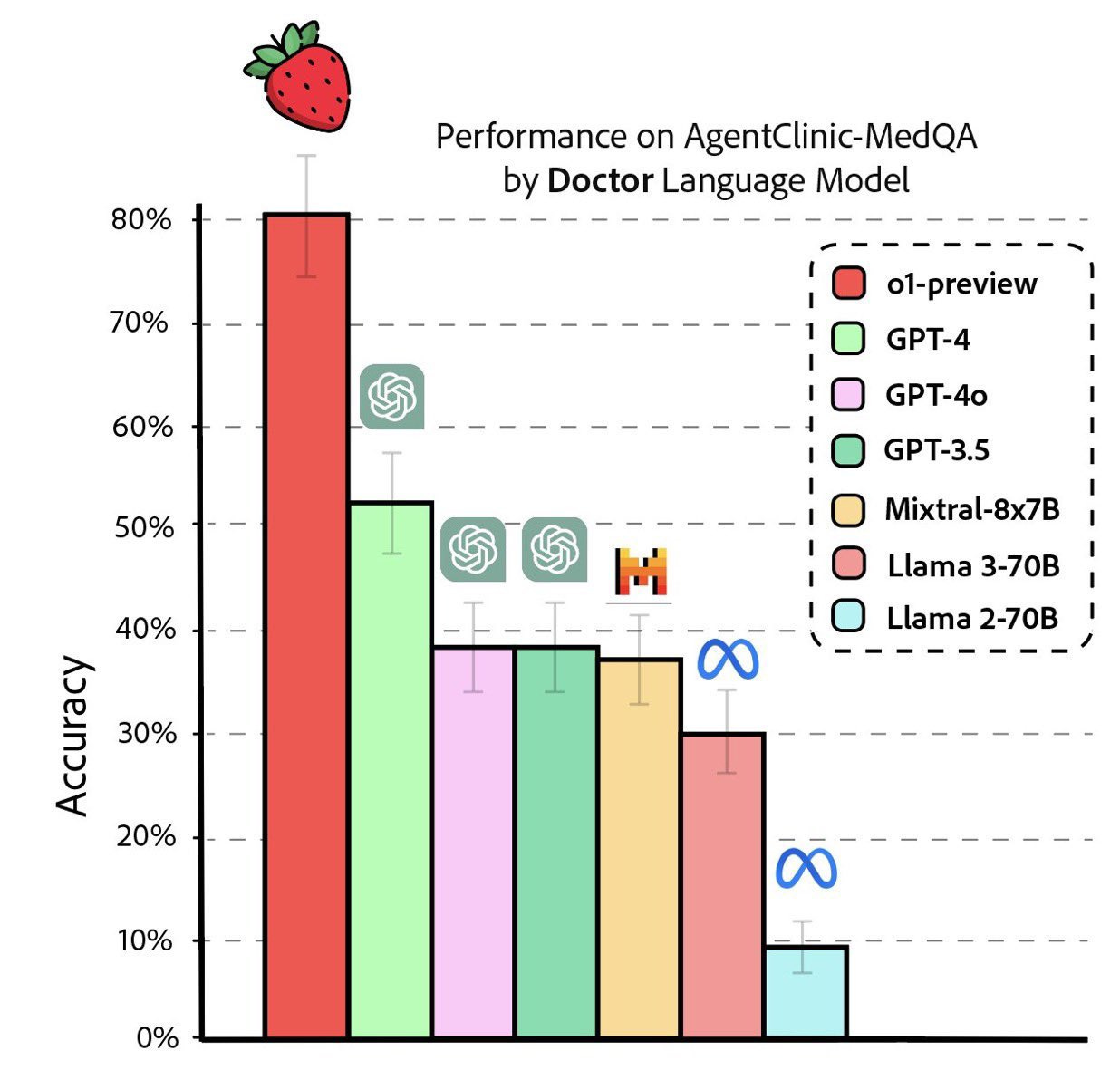On the Verge of Singularity
About Artificial General Intelligence, what The Singularity means, AI and clinicians, and does o1-preview get us closer to AGI?
Generative AI in healthcare has been my focus area for the last couple of years. During that time, my mind has been overflowing with ideas and concerns about Generative AI, its use in healthcare, and what it all means.
My path in Health Tech over the last decade has not been a conventional one. With so many stories from the tech frontlines, about projects we were involved in, technologies we built, do-good initiatives, wrong turns, ideas that came to life, people we tried to help. The Generative AI era puts it all on steroids. The stories keep coming, and many of them have never been told.
The devastating events of October 7 made me realize two things. The first one was that we all have to become better people, personally and professionally. The second was that had my life ended on that day, many of my stories would have remained untold.
And that led me to the creation of this blog, aiming to share AI knowledge with the medical community, explain AI concepts based on real life experiences and examples, and discuss the potential impact of AI technology.
It has been almost a year since.
This blog aims to share AI knowledge with the medical community, explain AI concepts based on real world experiences and examples, and discuss the potential impact of AI technology.
During the last year I shared few of those stories from the tech trenches in this blog, explaining AI concepts and approaches alongside the stories. Some of the stories are quite unusual, but they are all true. If you missed them, consider going back to those:
“Can Generative AI disrupt clinical trials?” shared the unusual story of Project New Hope, that eventually got me to present at the White House. Yeah, no kidding.
And then in “Generative AI and the Hollywood strike” I experimented with Gen AI to turn the above White House story into a full feature film, explaining Gen AI across text, image and video generation. Film not done yet, maybe never will, but it was hilarious.
“Generative AI in a universe of medical protocols” discussed concepts like
non-deterministic models and temperature while sharing the unusual story behind one very famous protocol, where my team and I became digital first responders in a global healthcare crisis.“Lost in Translation” looked into Gen AI for translation of books, while explaining hallucinations and omissions in Generative AI. As a side note, reading has become my escapism this year, with a strong inclination toward no-violence, comfort fiction.
And in “Generative AI and Rare Disease” I shared the heartbreaking story of The Yellow Brick Road project, a project that has failed, and discussed Software as a Medical Device and face recognition technology.
Many more stories to be told, will continue sharing them in this blog.
Uncovering AI for Clinicians
One of the goals of this blog was to help healthcare professionals advance their AI understanding, explaining the jargon, the approaches we use, and how the technology works - to enable clinicians to critically evaluate AI technologies and use AI tools in a more informed and responsible way. Many of my readers are medical doctors, nurses, and health tech experts.
So, why name it “Verge of Singularity”, then?
Let’s uncover a few concepts.
The Turing Test
The Turing Test, named after the British mathematician Alan Turing, is a way of measuring a machine’s ability to show intelligent behavior that’s indistinguishable from a human. Turing proposed this test back in 1950, long before the era of modern computers, as a way to answer the question: “Can machines think?”
To pass the Turing Test, a computer program needs to engage in a natural language conversation with a human judge. If the judge can’t reliably distinguish the computer from a human based on the responses, the program is said to have passed the test.
Researchers recently claimed that ChatGPT using GPT4 has passed the Turing Test, demonstrating that most people couldn't distinguish ChatGPT from a human.
Officially, ChatGPT hasn’t passed the Turing Test yet, but we might be there already - looking at ChatGPT o1-preview released last week, its ability to generate responses that are human-like and its demonstration of reasoning are quite impressive.
What is Artificial General Intelligence (AGI)?
Artificial General Intelligence is the hypothetical stage where an AI system can perform any intellectual task that a human can, across a wide range of fields. That would be a versatile AI that could, for example, diagnose diseases, solve complex scheduling problems, analyze research papers, and even learn new techniques on its own, all with the abilities of a highly trained human expert.
AGI means an AI that can do anything a human can do, across various domains.
AGI is about creating machines that have human-like cognitive abilities and can generalize knowledge across different domains. However, AGI doesn’t mean that machines would surpass human intelligence, it means they would match it in terms of versatility and capability.
AGI and the Singularity are related concepts, but refer to different ideas.
What is the Singularity, then?
The Singularity, on the other hand, is a more speculative and broad concept. It refers to a theoretical future moment when technological growth becomes uncontrollable and irreversible, leading to profound changes in human civilization. This concept often revolves around the idea of AI surpassing human intelligence and starting to improve itself at an exponential rate.
Singularity is a hypothetical “point of no return” future event where AI surpasses human intelligence, leading to rapid, uncontrollable technological advancements.
The Singularity would mean AGI that not only matches human intelligence but also rapidly outpaces it. This AGI could design even smarter versions of itself, leading to AI capabilities exponential growth, beyond our control or understanding. The Singularity would be a point where the future becomes unpredictable, and the changes the AI would bring could be so profound that they fundamentally change human society.
So, are we there yet?
According to this recent Bloomberg article, OpenAI has defined a five levels to track its progress toward building artificial intelligence:
Prior to ChatGPT o1-preview, most of the industry seemed to think we were somewhere between Level 1 and Level 2 in the above scale. With the recent introduction of the new o1-preview and o1-mini models that include advanced reasoning, comes a question - are we at Level 2 already?
My two cents: o1-preview certainly gets us a step closer.
A recent X post this weekend by @DeryaTR_ suggested that o1-preview (aka the “Strawberry” model) made a performance leap in terms of accuracy on AgentClinic-MedQA, an interactive benchmark based on questions from the US Medical Licensing Exam (USMLE).
Have not seen the detailed research behind this yet, however, this seems quite impressive - even though USMLE typically presents textbook cases, and it is likely that some of the models were trained on this data.
ChatGPT itself continues to play it humble BTW, even with the new models:
While significant progress has been made in AI, most people think we are not yet at the point of AGI, let alone do we see an exponential growth of AI that surpasses human intelligence, aka the Singularity. So, in other words - no, we’re not there yet.
But - when AI technology is evolving so quickly, sometimes at a terrifying speed, it feels we are on the verge of a new era. Hence why I called this blog “Verge of Singularity”.
Hard to believe it has been almost a year. A year of sorrow and challenges but also a year of growth, learning and innovation.
And devastatingly, after an entire year, it is hard to believe that civilian hostages, women, elderly and children are still being held hostage by terrorists, and the world stands silent.
Special thanks to
for the guidance and mentorship in writing this blog.About Verge of Singularity.
About me: Real person. Opinions are my own. Blog posts are not generated by AI.
See more here.
LinkedIn: https://www.linkedin.com/in/hadas-bitran/
X: @hadasbitran
Instagram: @hadasbitran
Recent posts:










